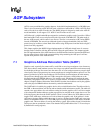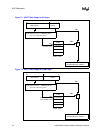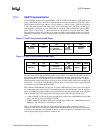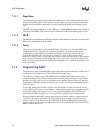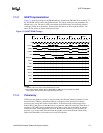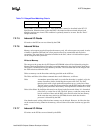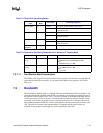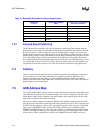
Intel® 460GX Chipset Software Developer’s Manual 7-9
AGP Subsystem
this point the inbound Expander logic establishes a pseudo-lock and will no-longer send
coherent requests from the AGP streams. Non-coherent requests can still be issued, but
anything that can block the PCI stream in the SAC’s queues must be held in the GXB.
5. The outbound Locked Write request is transferred across the Expander bus.
6. An Unlock transactions is transferred across the Expander bus (locked writes are posted; the
Unlock will occur once the system bus lock goes away, so this will occur even if the data has
not been delivered to its destination). The Unlock request, which throughout the Expander
queues has the same semantics as a posted write, must be pushed into the outbound PCI queue
behind the Locked Write.
7. When the Locked Write reaches the head of the outbound PCI queue it is performed on the
AGP Bus with PCI semantics.
8. When the write completes on the AGP bus, a Write Completion is pushed into the inbound PCI
transaction queue.
9. The Unlock transaction reaches the head of the outbound PCI queue.
10. A write completion for the Unlock transaction is placed in the inbound PCI transaction queue.
At this point the PCI interface’s pseudo-lock is released.
11. Both the completion for the locked write and for the Unlock transaction are delivered over the
Expander bus. When the Expander logic transmits the completion for the Unlock transaction,
its pseudo-lock is released.
7.2.6 Address Alignment and Transfer Sizes
The AGP specification allows the graphics card to request reads of size 8-64 bytes in eight-byte
increments or of size 32 to 256 bytes in 32-byte increments. Reads and writes are both aligned on
any 8-byte boundary. There is no concept of cache-line aligned or even page aligned. The request
may cross a page boundary and require 2 translations. There is no requirement that the physical
addresses resulting from the translation be contiguous. There is also no requirement that the
coherency be the same on these two pages.
7.2.6.1 Address Faults
See the ‘ERROR’ chapter for the GXB behavior on addresses that are considered illegal.
The graphics card may do AGP transfers to areas outside the GART range. There is no translation
on these addresses, so the graphics card must use the physical DRAM address for the object it is
attempting to access. This is perfectly acceptable, but the graphics card and device driver must be
able to provide the correct physical address to be used.
7.2.7 PCI Semantics Traffic
7.2.7.1 Inbound Reads
Delayed Transactions
The GXB supports the Delayed Transaction mechanism as defined in the PCI 2.2 Specification.
The process of latching all information required to complete the transaction, terminating with
Retry, and completing the request without holding the master in wait-states is called a Delayed
Transaction. The GXB will delay all memory space read requests (unless a delayed slot is
unavailable); no other request types are delayed.



